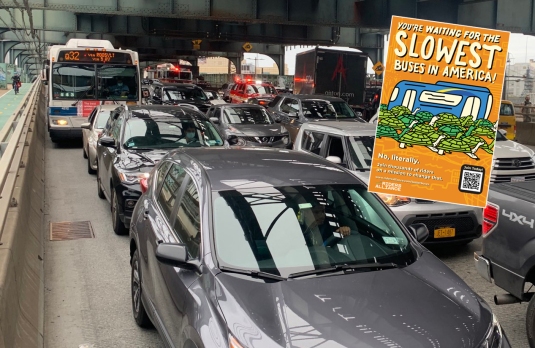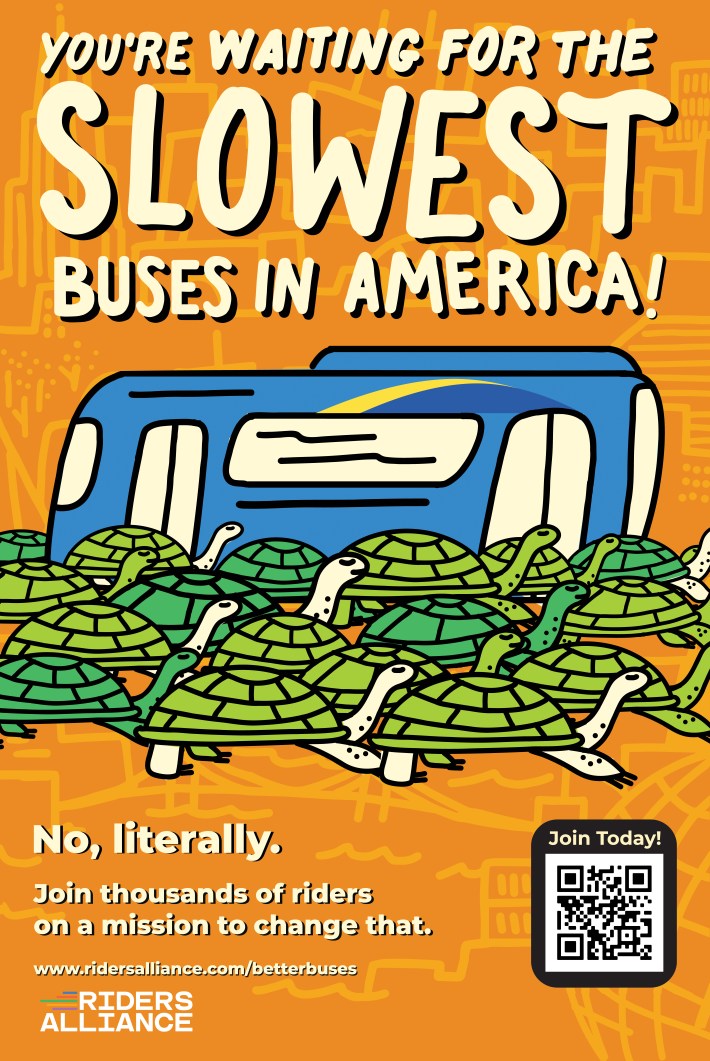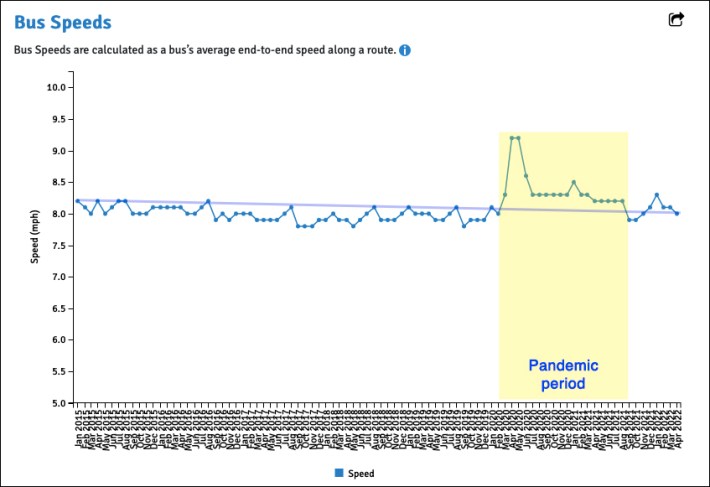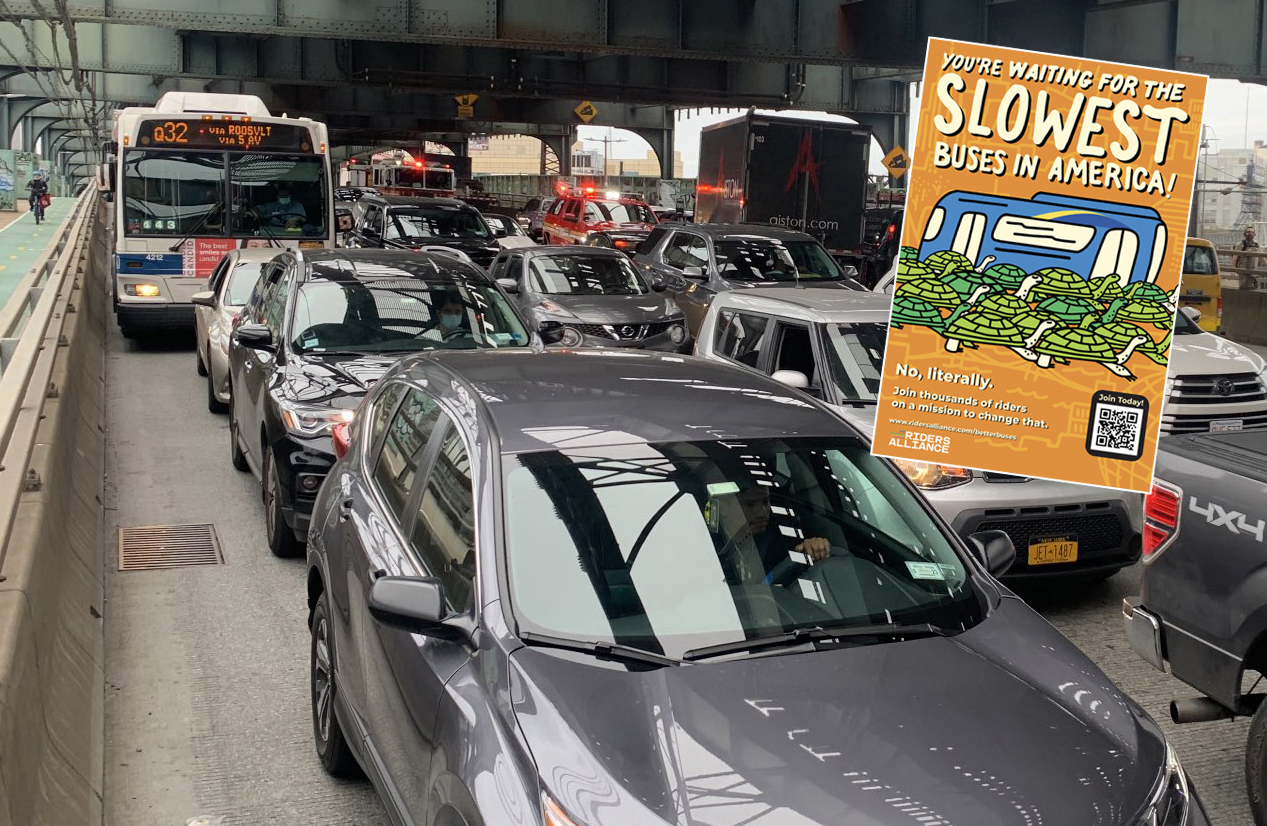

Aw, look at the cute turtle — and those green tortoises are fun, too!
With the Adams administration moving at New York City bus speed to undo the previous administration’s ignominious transit legacy, Riders Alliance will unveil three bus shelter ads to demand change — and one makes the case with that most damning symbol: our buses are slower than an Aldabrachelys gigantea.
The posters by gifted illustrator Courtney Menard (one of which is featured at right) will grace 35 bus shelters in Brooklyn, Queens and the Bronx. Riders Alliance will unveil them at noon today with a rally in Jamaica that is “aimed to recruit frustrated commuters to do what it takes to win better public transit service for the millions of New Yorkers who depend on it,” the advocacy group said in a statement.
The Streets Master Plan requires the city to build 150 miles of bus lanes by the end of 2026, with a minimum of 20 lane miles in the first year, but the Adams administration has not gotten a quick jump. As of May, the Department of Transportation has presented only three bus lane projects of roughly 14.6 miles, so advocates are naturally wondering if the agency will lay down enough red paint to meet its first hurdle. (The Streets Master Plan also requires the installation of a minimum of 30 miles of protected bike lanes in 2022, and 250 miles overall in five years.)
“It’s months into painting season already. Not only have we seen no new bus lanes in the Adams administration, we haven’t seen a path forward from City Hall to meet this year’s legal mandate,” Riders Alliance spokesman Danny Pearlstein said.
As a candidate and as a mayor, Eric Adams has championed the idea of fixing the city’s slowest-in-the-nation buses, which stagnated under his predecessor, who entered office in 2014 promising a “world class” Bus Rapid Transit Network but left with the vast majority of bus routes in worse condition. Shortly after Bill de Blasio took over, overall weekday bus speeds were 8.2 miles per hour citywide, according to the MTA’s bus dashboard, which begins in January, 2015, and as of November 2021, those buses are running at an average of just 8 miles per hour.

And those stagnating numbers came even after the de Blasio administration’s greatest successes: four largely car-free busways that sped up buses on 14th and 181st streets in Manhattan; on Jay Street in Brooklyn; and on Main Street in Queens.
Adams recently told the Times that he intends to install 150 miles of bus lanes and busways by the end of his first term — one year before the Streets Master Plan deadline.
“Our bus lanes and busways have created a national model for speeding up service and improving reliability for hundreds of thousands of bus commuters,” said DOT spokesman Vin Barone. “Fast, reliable service is critical for reducing New Yorkers’ dependency on cars and cutting through gridlock on our streets. We appreciate Riders Alliance’s advocacy on behalf of bus riders and look forward to working with the MTA on exciting new projects across the boroughs.”
Slow buses are not merely an inconvenience to riders (though that they surely are). But poor service causes the MTA to bleed ridership, which undermines the agency’s revenue stream because that roughly half of the MTA’s cash comes from fare collection.
Bus ridership last Thursday (the most recent weekday available) was 1,305,674 or still down from its pre-pandemic 2019 average of 1,770,394 rides per day. But bus ridership has fallen even more profoundly since 2014, when the average weekend had 2,123,092 rides, according to MTA data.
On the plus side, the DOT did just win a $780,100 grant from the federal Department of Transportation to “support planning, service and reliability improvements on three Brooklyn Bus Corridors (B15, B35, B41).” The B15 runs between Bedford-Stuyvesant and JFK Airport, the B35 between Brownsville and Sunset Park, and the B41 (the borough’s beleaguered workhorse) runs on Flatbush Avenue between Kings Plaza Mall and Downtown Brooklyn.
According to the feds, the study “will evaluate opportunities to improve operational performance on these routes.”
More than study is badly needed. According to the MTA, weekday bus speeds on the three lines in question are worse than even under Mayor de Blasio:
- The B15 was traveling its route at an average of 8.5 miles per hour in February 2020, the last full month before the pandemic. In April 2022, the last full month for which there is data, those speeds had dropped to 7.6 miles per hour. That’s a decline of 10 percent.
- The B35 went from 5.6 miles per hour to 5.5 miles per hour.
- The B41 stayed at 6.5 miles per hour, which hardly counts as a victory, given that weekday bus speeds on the entire system remain flat: from 8 miles per hour in February 2020 to 8 per hour in April 2022.
It’s unclear what the study will reveal — high car volumes and truck double-parking are already widely established as the basis for slow bus speeds — but the DOT is eager to get to work.
“We are always looking to improve bus speeds and reliability in partnership with the MTA, particularly along high ridership routes like the B15, B41 and B35,” said Tomas Garita, an agency spokesman. “This grant will help us achieve those goals and we look forward to putting this funding to good use. We’ll have more to share soon.”
Rally for better buses, Tuesday, June 7, noon, at Jamaica Center (south side of Archer Avenue at Parsons Boulevard, bus bay D).






